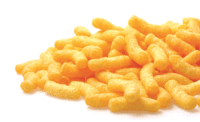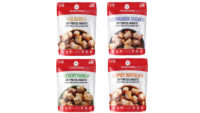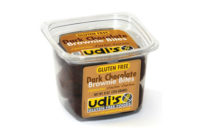Gluten-Free Pastas
Many companies are taking a culinary approach and creating gluten-free pastas that satisfy with the same organoleptic qualities as mainstream products.

 |
|
While sauces get healthier, the noodle itself is enjoying leaps iningredient science to do the same. Ingredients, such as resistant starch, pea protein, gluten-free flours and other components, can be incorporated without compromising on organoleptic characteristics.
|
When it comes to gluten-free noodle development, there’s a vast difference between the traditional dried pasta that’s been around for centuries and gluten-free versions. Challenges are many, including: low protein; leaching of the flour and starches into the cooking water; and bland taste.
A typical egg-noodle pasta consists of durum wheat flour (a particularly high-protein variety), egg yolks or eggs, and water. The ingredients might be basic, but the right technique requires expertise and great care. The dough must be kneaded to develop the gluten and water matrix, then rolled continuously in a pasta sheeter to stretch and “relax” the dough before cutting. It’s a complex process that is as much art as it is science.
Most gluten-free pastas combine two or more grain flours with various sources of gums and/or protein. For example, Delallo Inc. brand gluten-free offerings are made of corn and rice flour, while Hain-Celestial Group Inc.’s DeBoles brand noodles use rice flour and rice bran extract. The company also makes a rice-and-flax spiral consisting of whole-grain, parboiled brown rice flour, rice flour, golden flax, rice bran extract, plus vitamins and minerals. The Quinoa Corp.’s Ancient Harvest makes elbow pasta with a blend of organic corn and quinoa flour.
While many of the items contain a mixture of gluten-free grains, most of them are low in protein compared to traditional pasta. Protein is essential to the binding properties of pasta, and traditional pasta contains around 8g of it per serving. The gluten-free pastas contain about 3-4g of protein, with Annie’s Homegrown Inc.’s pasta offerings listing the highest protein content, at 6g.
Several ingredient companies support gluten-free offerings via high-protein, gluten-free flours or ingredients with colloidal properties. Among the most recent entrants is a maker of flour from Australian dehulled lupin beans. The high-protein lupin bean skin is removed, to exclude fibers which adversely affect the mouthfeel and functional properties of the flour.
Lupins for commercial use also are now being grown in northern California and Oregon. Even without its skin, the flour is high in protein and fiber (approximately 30–40%). Several U.S. companies currently are experimenting with the bean flour for pasta.
Another gluten-free flour offering is from defatted, milled chia seed, already popular for being a good source of ALA omega-3 fatty acids (242mg per serving), as well as a good source of fiber (about 4g per serving) and 4.6g protein. The defatted protein/fiber-rich fraction of chia seed contains 54% of total dietary fiber, 29% protein and 7% fat—of which 4% is ALA.
Flax seed, too, is a hydrocolloidal ingredient well-suited for gluten-free pasta. One supplier developed a pasta composed of corn starch, corn flour, rice flour, milled flax seed and mono- and diglycerides. It made for a firmer, more cohesive pasta as compared to a control noodle formula.
Many companies are taking pasta and sauce dinners to the next level of flavoring. Denver-based Pasta Moré Gourmet Foods created Spinach Basil Garlic Linguini and Sweet Potato Fettuccine as gourmet, gluten-free pasta. Yet, even with multiple processors getting in on the act, demand is still high enough that the market has yet to close on gluten-free.
Looking for a reprint of this article?
From high-res PDFs to custom plaques, order your copy today!





